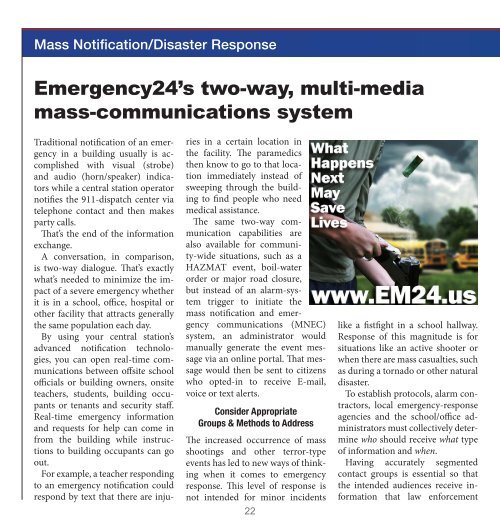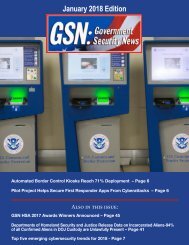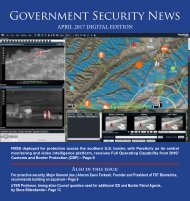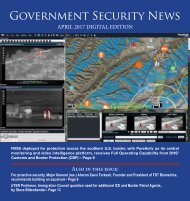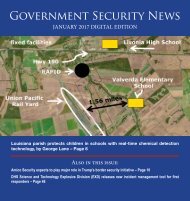GSN_Nov-Dec_FINAL_Yumpu
You also want an ePaper? Increase the reach of your titles
YUMPU automatically turns print PDFs into web optimized ePapers that Google loves.
Mass Notification/Disaster Response<br />
Emergency24’s two-way, multi-media<br />
mass-communications system<br />
Traditional notification of an emergency<br />
in a building usually is accomplished<br />
with visual (strobe)<br />
and audio (horn/speaker) indicators<br />
while a central station operator<br />
notifies the 911-dispatch center via<br />
telephone contact and then makes<br />
party calls.<br />
That’s the end of the information<br />
exchange.<br />
A conversation, in comparison,<br />
is two-way dialogue. That’s exactly<br />
what’s needed to minimize the impact<br />
of a severe emergency whether<br />
it is in a school, office, hospital or<br />
other facility that attracts generally<br />
the same population each day.<br />
By using your central station’s<br />
advanced notification technologies,<br />
you can open real-time communications<br />
between offsite school<br />
officials or building owners, onsite<br />
teachers, students, building occupants<br />
or tenants and security staff.<br />
Real-time emergency information<br />
and requests for help can come in<br />
from the building while instructions<br />
to building occupants can go<br />
out.<br />
For example, a teacher responding<br />
to an emergency notification could<br />
respond by text that there are injuries<br />
in a certain location in<br />
the facility. The paramedics<br />
then know to go to that location<br />
immediately instead of<br />
sweeping through the building<br />
to find people who need<br />
medical assistance.<br />
The same two-way communication<br />
capabilities are<br />
also available for community-wide<br />
situations, such as a<br />
HAZMAT event, boil-water<br />
order or major road closure,<br />
but instead of an alarm-system<br />
trigger to initiate the<br />
mass notification and emergency<br />
communications (MNEC)<br />
system, an administrator would<br />
manually generate the event message<br />
via an online portal. That message<br />
would then be sent to citizens<br />
who opted-in to receive E-mail,<br />
voice or text alerts.<br />
Consider Appropriate<br />
Groups & Methods to Address<br />
The increased occurrence of mass<br />
shootings and other terror-type<br />
events has led to new ways of thinking<br />
when it comes to emergency<br />
response. This level of response is<br />
not intended for minor incidents<br />
22<br />
like a fistfight in a school hallway.<br />
Response of this magnitude is for<br />
situations like an active shooter or<br />
when there are mass casualties, such<br />
as during a tornado or other natural<br />
disaster.<br />
To establish protocols, alarm contractors,<br />
local emergency-response<br />
agencies and the school/office administrators<br />
must collectively determine<br />
who should receive what type<br />
of information and when.<br />
Having accurately segmented<br />
contact groups is essential so that<br />
the intended audiences receive information<br />
that law enforcement


